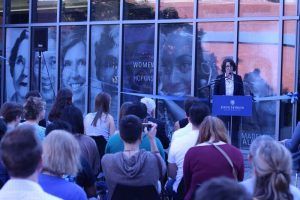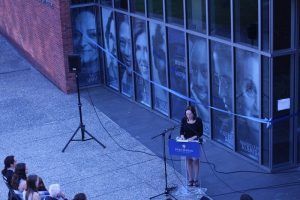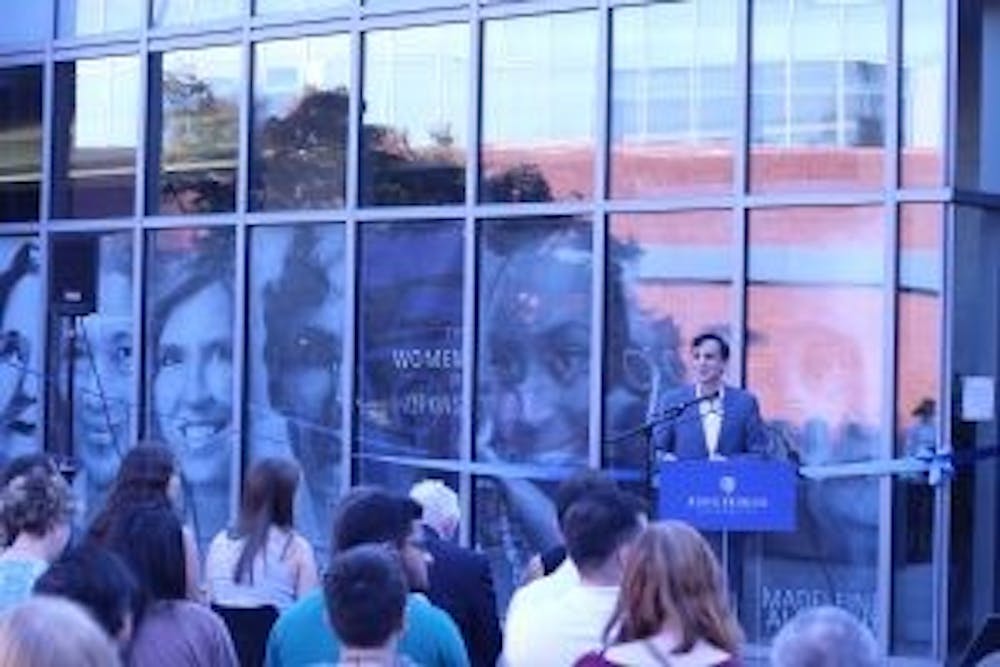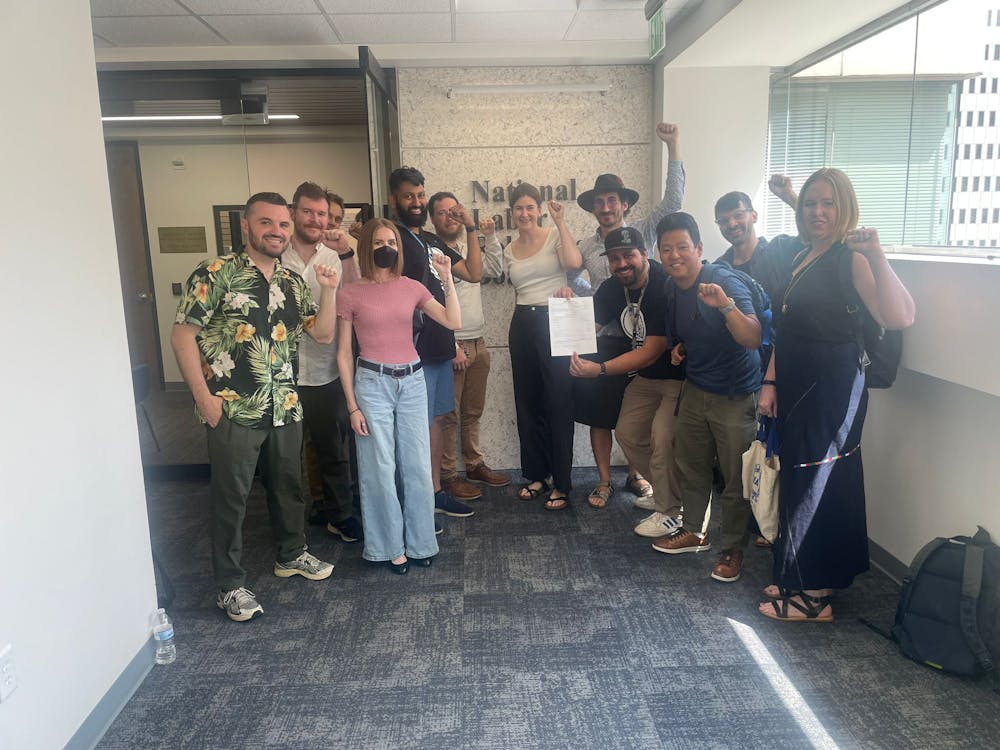In celebration of some of its most accomplished female affiliates, the University held a ribbon cutting ceremony for the new Women of Hopkins installation at the Mattin Center courtyard on Tuesday afternoon.
The 600-square foot installation, consisting of posters featuring the faces of 23 Hopkins women, showcased both notable alumnae and staff.
University President Ronald J. Daniels opened the ceremony, praising the role that women have had throughout Hopkins history.
“We know that in recognizing women of Hopkins past and present, we’re not so much honoring them, rather we are celebrating the honor that they have done to us by being part of our community,” Daniels said.
Honoree Gail Kelly worked in the United States Department of Health and Human Services supporting behavioral health care. She has also been involved with various projects involving mental health, cancer, infectious diseases and HIV/AIDs. She was a graduate of the Class of 1974, the first undergraduate class at Hopkins to accept women.
Kelly was one of Hopkins’ first three African-American female students.
“As part of creating that new class, the school elected to bring publicly educated kids [from Baltimore],” Kelly said. “I was the last one admitted, and that’s because I was the first in my family to go to college. They were kind of leery: ‘What do you want to go to college for? All you got to do is get married and have a baby.’”
According to Kelly, she never felt stigmatized at Hopkins. The other students were generally respectful and accepting of her place at the University, though she did have her share of bizarre experiences. The new women’s bathrooms were one example of this.
“They just took off the signs of male bathrooms and put ‘Women’ up there,” she said. “So you walk in the bathroom and you go: ‘What’s this big water fountain?’ No. That’s a urinal. ‘A urinal? Wow!’ A lot of it was that. The bathrooms, and there [wasn’t] any formal physical education or sports for women.”
Kelly, who had attended an all-girls high school, said that she definitely felt out of her comfort zone when she first came to Hopkins.
“You feel a little awkward,” she said. “Do I talk? Will they listen to me? It was a crash course in how to operate in... a male world that I didn’t have in high school. I was just awestruck seeing all these males, and trying to talk, assert your perspective, your opinion.”

According to Kelly, the challenge of having to adapt to a nearly all-male environment was important for her development as a young woman.
“When I left here, I felt fully respected,” Kelly said. “The guys you knew felt you were kind of special. You tolerated them, and you were with them through their educational experience. It gave me a sense of feeling empowered going into the work world, understanding how men function and operate.”
Kelly also offered advice for women at Hopkins today. She quoted Eleanor Roosevelt, encouraging everyone to “do one thing every day that scares you,” regardless of the field they specialized in, highlighting the importance of taking action.
“Once you [do something that scares you everyday] you realize: I can do anything,” Kelly said. “[It] means that you can make a difference in this world, whatever field you’re supposed to be in. So whatever field you are in — science, engineering, liberal arts — you impact people, you touch people, you feel as though... you’ve made a difference. As you get older it’s those things that give you the feeling of ‘Hey, life’s been great. I’ve done something worthwhile.’”
The installation was organized primarily by graduate students Dominic Scalise and Anna Coughlan. Karen Fleming, Jeff Gray and Valerie Hartman of the Hopkins Diversity Leadership Council and Jeannine Heynes, the University’s director of gender equity, also played a major role in making the event a reality.
Scalise, however, pointed out that although the organizers worked to bring the variety of stories together, the women themselves were the ones who had worked to become the agents of change.
“These legacies are a priceless cultural asset for the Hopkins Community,” Scalise wrote in an email to The News-Letter. “All we did was polish and present their stories.”
In addition to honoring the legacy of these women, Scalise also organized the project to help further gender equity on campus.
“An indirect result we hope to see come from this project is increased gender and racial diversity in traditionally white-male fields, including STEM, business, politics, and medicine,” he wrote. “There is a growing body of research that shows more diverse institutions are also more innovative institutions.”
The roots of the Women of Hopkins project go back to 2014, when Dr. Karen Fleming, professor of biophysics, started a series of gender equity reading groups on campus to discuss barriers faced by women in the sciences.
These reading groups discussed various articles and studies related to gender, including a groundbreaking study that sent out two CVs to U.S. science labs for manager positions. One was for a fictional applicant named John and the other for a fictional applicant named Jennifer.
“The faculty heads of each lab were asked to state how likely they were to hire the applicant, how much they would pay, and how likely they would be to personally mentor the applicant,” Scalise wrote. “In all three cases the male candidate, John, was rated significantly higher than the female candidate, Jennifer. Specifically, John was about 25 percent more likely to be hired. The catch was that both CV’s were exactly the same, except for the names and gender pronouns.”
Soon afterward, Jo Handelsman, associate director of the White House’s Office of Science and Technology Policy and one of the authors of the study, was invited to speak at Hopkins on Mar. 8.
“At the end of her talk, Dr. Handelsman suggested that one way to break down gender barriers is to use the empty spaces around campus to highlight successful women from our campus as role models,” Scalise wrote. “As you can see, we took Dr. Handelsmann’s suggestion.”

Scalise regretted that more women could not be included in the installation due to a limited budget. In addition to considering general accomplishments, the organizers endeavored to make the final selection as diverse as possible with regards to race, field of accomplishment and the time period the women were from.
“The greatest challenge, and my least favorite part of the project by far, was selecting the women we are honoring,” Scalise wrote. “Clearly it is impossible to celebrate all of the incredible women affiliated with our campus with such a small selection, and we regret leaving out the many additional candidates who deserve celebration. We have a growing list of over 50 candidates who have been suggested to us, which we will draw from if we are able to expand the project.”
Students and other visitors at the event had the opportunity to speak with Gail Kelly and take photos with her. Sophomore Bianca Martone appreciated this interactive aspect of the ceremony in addition to the installation.
“It’s just inspiring to be here,” Martone said. “You know there are women who have graduated from the university and have done great things but you do not always get to see them so plainly like this. It’s inspiring to see all their faces and read some of their stories and get to know them.”
Senior Hannah Lin also saw the installation as a noteworthy step forward in the advancement of gender equity on campus.
“Ever since I’ve come to Hopkins, there hasn’t really been a thing that goes, ‘Women at Hopkins matter,’” Lin said. “Of course everyone is like: ‘Oh yeah gender equity, we’re all about that.’ But in so many instances and so many fields you see this kind of imbalance. I’m not saying it’s Hopkins’ fault, it’s more of an institutional, systematic thing.”
However, Lin felt that more could have been done to make the ceremony more effective in increasing the awareness of Hopkins women’s achievements.
“People pass Mattin a lot, so that’s good,” she said. “But I think something interactive would be more likely to actually engage people, make them think more deeply about the matter. That’s very hard.”
A potential improvement that Lin mentioned was making the event more of a “human library” to encourage conversations and to better relay personal insight regarding women’s experiences.
“I’m thinking of exhibits like human books where you literally take a human, talk with someone and they tell you their story. That to me seems very personal,” Lin said. “We would be able to engage more deeply instead of walking by a set of posters. But that’s also hard, and not something you can have on the whole time.”
Scalise and the rest of the organizing team see this installation as a stepping stone for cementing gender equity and promoting diversity on campus.
“Now our team hopes for a groundswell of support to drive culture change,” Scalise wrote. “If the Hopkins community voices their enthusiasm for the Women of Hopkins project, then we can pursue the resources to expand the project, and to invite our honorees to speak on campus for Women’s History Month in March 2017.”





